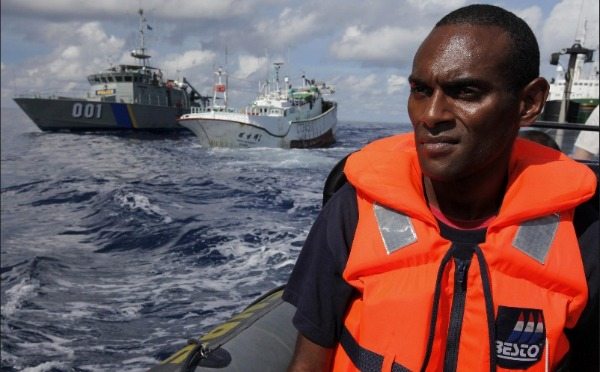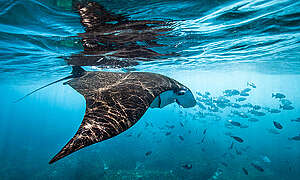SYDNEY, 30 MARCH 2015 —- There could soon be a whole lot more demand for sustainably caught tuna from the Pacific. For the first time ever, Greenpeace has just released a canned tuna guide in the United States – the largest tuna consuming nation in the world.
Opinion Editorial by Lagi Toribau in Islands Business
The question is, can Pacific Island Countries move to meet this emerging demand?
The new Greenpeace canned tuna guide, launched with considerable fanfare, ranks US brands from best to worst, offering American shoppers a way to choose fair and sustainable tuna from the Pacific region. So why is a shopping guide like this needed?
Americans eat the most canned tuna of any country in the world, yet 80% of tuna sold in the US comes from unsustainable and destructive sources.
Every year millions of tonnes of yellowfin, bigeye, albacore and skipjack are hauled out of the ocean by multinational companies chasing profits for their already wealthy shareholders.
Often propped up by government subsidies, too many of these companies ignore borders and regulations, raid the territorial waters of vulnerable Pacific states, and treat their workers as slaves.
They strip-mine the oceans using highly destructive fishing techniques such as purse-seine nets on fish aggregation devices (FADs) which have a devastating impact on iconic species like sharks, turtles, and marine mammals, not to mention the very fish their businesses are built upon.
We cannot afford to overfish tuna. When it comes to destructive tuna fishing, Pacific Islanders lose out more than anyone. Despite supplying more than half of the world’s tuna, just a fraction of the profits from the $7 billion tuna industry is returned to.

More importantly, almost all Pacific Islanders rely on seafood as our main source of protein. We simply cannot afford to overfish.
There are Pacific connections all through the new US tuna guide. Starkist and Bumble Bee are down amongst the worst performers. Bumble Bee has its biggest cannery in Fiji and Starkist has its main cannery in American Samoa. Although both companies contribute to local economies through employment, they are intent on fishing every last tuna from our ocean. This will leave us not only jobless but without out natural resource and forced to import expensive food from the west.
Tri-Marine’s Ocean Naturals brand rated third from the top. With a new processing plant in American Samoa, Tri-Marine’s sustainability policies, while not yet perfect, are a model of how Pacific Fisheries can be.
Getting the US market right, by driving out these unsustainable and destructive products and replacing them with sustainably and fairly caught tuna, will reinforce the huge changes already taking place in many smaller markets around the world.
In the United Kingdom, Australian and New Zealand, Greenpeace tuna rankings have already led to astonishing changes in purchasing behaviour.
Armed with information, consumers revolted against the cruel and wasteful catch of turtles, sharks and baby tuna in FAD and purse-seine fisheries. Almost all of the major brands and retailers in these markets committed to transition 100% of their tuna supply away from destructive FAD fishing as a result.
How Pacific business can move to meet demand for sustainable tuna?
In the Pacific, the increasing demand from major markets wanting sustainable and socially responsible tuna creates an opportunity for locally owned and operated sustainable fishing operations. My experience has been that brands change most quickly when they can find suitable partners on the supply side of the equation. Pacific Islanders should be taking advantage of this opportunity and maximising their potential, both participating in and protecting the future of Pacific tuna.
In 2009 Greenpeace secured 70 million cans of pre-ordered pole and line caught tuna. Pacific countries must now step in to meet this demand.
Transforming our tuna fishery
A transformed tuna fishery in Pacific Island countries would combine methods of fishing such as pole and line, troll, and handline, with free-school purse seine and best-practice longline. Tuna species would be harvested at sustainable levels, with minimal bycatch. Tuna fishing vessels would be owned and operated by Pacific island communities and local entrepreneurs. Artisanal and village-based fisheries would be organised as cooperatives to coordinate the sale of their catch and set the strategic direction for their
The hope is that these changes, from retailers and brands demanding sustainable tuna, will force change in the Pacific fishing industry. And with an increasing number of progressive companies offering sustainable tuna to consumers, the question is not ‘who will be the next tuna brand to change’ but ‘how can locally-owned businesses in the Pacific move to take advantage of these changes?’
Lagi Toribau from Fiji is the leader of the global tuna political project with Greenpeace. With over a decade of experience, he has led numerous ship tour expeditions targeting pirate fishing and tuna overfishing in the Pacific as well as heading Greenpeace’s participation in key regional and international fisheries political meetings. Most recently, Lagi has worked as Head of Program for Greenpeace East Asia, leading the establishment of program operations in Korea and setting up the oceans campaign in mainland China.


